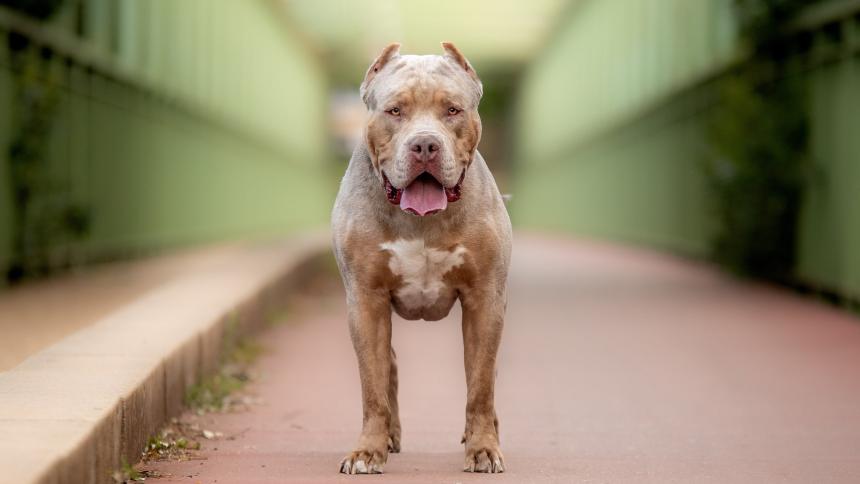
Deadly XL Bully attacks in the UK
On Crimes That Shook Britain, broadcaster Dermot Murnaghan is joined by a team of experts and witnesses to examine cases that gripped the nation to explore how they shaped public conversation. Series nine airs Mondays at 9pm on Crime+Investigation and features some of the most high-profile XL Bully attacks in the UK.
Fatal dog attacks are a tragic and complex issue, often sparking heated debates over breed-specific legislation and owner responsibility. In the UK, a spate of attacks involving XL Bullies over several years led to significant public concern and changes in the law.
Between 2021 and 2023, around half of fatal dog attacks in the UK were caused by a single breed, the American Bully XL. In September 2023, Prime Minister Rishi Sunak announced that the breed would be banned. The ban, which was brought into effect in early 2024, made it illegal in England and Wales to sell, breed, abandon or give away an XL Bully, to possess one without a Certificate of Exemption, or to have one in public without a lead and muzzle.
In this article, we look at the most notable XL Bully cases, examine the evolving legislation surrounding these dogs, and discuss the legacy of these terrible events.
Jack Lis – November 2021
One of the most heartbreaking incidents involved 10-year-old Jack Lis from Caerphilly, Wales. In November 2021, Jack was mauled to death by an XL Bully named Beast while visiting a friend’s house. The attack led to the prosecution of Amy Salter and Brandon Hayden, who were responsible for the dog. The pair were jailed for three and four years, respectively, for owning a dangerously out-of-control dog that resulted in the death of a child.
The shocking nature of Jack’s case highlighted severe lapses in the regulation and control of powerful dog breeds. It ultimately led to calls for stricter owner accountability and proactive measures to prevent such tragedies in the future.
Shirley Patrick – December 2022
Just over a year after the death of Jack Lis, 83-year-old Shirley Patrick was attacked by an XL Bully named Junior in her own home, also in Caerphilly.
The dog, which belonged to a family member, turned on her suddenly, causing fatal injuries. Shirley suffered 'traumatic lacerations' and significant wounds to her head, body, face and arms during the attack, and died in hospital 17 days later.
The tragedy happened just half a mile from the house where Jack Lis had been killed the previous year.
Jonathan Hogg – May 2023
In May 2023, another devastating incident occurred in Greater Manchester, where 37-year-old father-of-five Jonathan Hogg was fatally attacked by an XL Bully called Poseidon.
Jonathan had been looking after his friend's two dogs when one suddenly attacked him after he entered the animals’ pen. The horrific attack lasted for around 15 minutes until Jonathan became unconscious.
A trauma doctor later described the injuries as the ‘single worst trauma case’ he'd seen in his 10-year career. This shocking event drew significant media attention and debate on a future ban of the breed.
Angeline Mahal – May 2024
Fatal XL Bully attacks have continued in the UK even after the ban was introduced in February 2024.
In May 2024, a woman in her 50s named Angeline Mahal died in her home in east London after being attacked by two dogs she owned. The dogs had been registered as XL Bullies, meaning they had been neutered, microchipped and were to be kept on a lead and muzzled in public.
According to several reports, relatives of Mrs Mahel had previously begged her to get rid of the dogs which she’d owned since they were puppies.
The history of the Dangerous Dog Act 1991
The UK’s approach to regulating dangerous dogs has changed significantly over the decades. The Dangerous Dogs Act 1991 (DDA) was introduced following a series of high-profile attacks and aimed to reduce the risk posed by certain breeds.
The Act initially banned four breeds: Pit Bull Terriers, Japanese Tosas, Dogo Argentinos and Fila Brasileiros. It was a controversial piece of legislation in 1991, as Britain became one of the first countries in the world to ban specific breeds.
The XL Bully was the first breed to be added to the list since the Act was originally introduced, a move that received considerable public support. Campaigners and relatives of victims believe that the Act has to be kept up to date to reflect future threats and trends in dog breeding.

Criticisms of the DDA
Despite its intentions, the DDA has faced substantial criticism. Prominent critics, including the RSPCA, Dogs Trust and Kennel Club, argue that the Act focuses too heavily on specific breeds rather than addressing broader issues of owner responsibility and dog behaviour.
The Act has been repeatedly criticised for its ineffective enforcement and the difficulties in accurately identifying banned breeds, which has led to inconsistencies in its application.
Critics of the Act believe a better approach would include mandatory licenses and training for all owners, better education on dog behaviour and stricter penalties for irresponsible owners.
An emotive and challenging subject
Figures from a Freedom of Information request earlier this year revealed that 400 XL Bully dogs have been euthanised since the ban was introduced. It also showed that the number of this breed of dog is far greater than had initially been thought.
The government previously believed there were 10,000 dogs in the country, but over 55,000 exemption certificates have been issued to owners who want to keep their pets. Animal charities have warned that the true number could be as high as 100,000, meaning tens of thousands of dogs remain unaccounted for.







